Topics
Category
Era
Duluth Incline Railway
The Duluth Incline as it appeared with two large cars capable of carrying wagons and teams, crossing Fourth Street at Seventh Avenue, 1892.
Seventh Avenue West and Fourth Street, Duluth
In December 1891, the Duluth Street Railway Company opened an incline railway on the right-of-way of Seventh Avenue West. The company had received a charter from the state in 1881 to build a streetcar line for Duluth, and this railway was part of the larger system. The hillside was too steep for a regular rail line, and cable powered lines were often used in similar situations.
From a base station on Superior Street, the Incline (as it was known) climbed 509 feet in slightly more than half a mile. The grade ranged from 15 to 25 percent. Riding along the ten-foot gauge track, the original pair of forty-one by fifteen-foot cars counterbalanced each other, one going up while the other one descended. They were built to accommodate four teams and wagons, or up to 250 standing passengers. The Incline was powered by a stationary steam engine at the top; a one-way trip took sixteen minutes.
When the hoped-for ridership failed to develop, the railway company decided to offer a variety of attractions. On July 4, 1892, it opened the Beacon Hill pavilion at the top of the Incline. The pavilion featured a restaurant and theater, and was the site of such events as hot-air balloon launchings.
A fire in the powerhouse engine room on May 28, 1901 spread to the pavilion, destroying both structures. The intense heat melted the cable, releasing one of the twenty-seven-ton Incline cars, which was also on fire. The flaming car raced down the track and demolished the base station at Superior Street. Amazingly, no one was injured.
The Incline was out of service until January 1, 1902. When service resumed, a single vehicle resembling a streetcar (twenty-two feet long by eight feet wide) ran on the west track, balanced by a counterweight on the east track. Electric motors replaced the steam engine. Intermediate stations were located at Fourth, Fifth, and Seventh Streets.
A single car providing service only once every half hour eventually proved to be inadequate, so, in 1911, the Incline was again modified. Two somewhat larger new cars (each twenty-four feet long by eleven feet wide) were raised and lowered by an electric hoist at the top of the Incline. An engineer ran the hoist, and each car carried a conductor, who operated the doors and brakes, collected fares, and communicated with the engineer by telephone.
The line was designed with five relocated intermediate stations that were spaced so that, when stopped, both cars would simultaneously be at a station. Once stopped, both conductors had to give the engineer an all-clear signal before either car could start moving. Cars ran every fifteen minutes, with a one-way trip taking eight minutes at six miles per hour.
A survey taken in 1925 shows that the Incline carried an average of 2,170 weekday passengers. By contrast, the connecting Highland streetcar line carried an average of only 1,114 weekday passengers. Not surprisingly, hourly checks showed that most riders traveled downhill in the morning rush hour and uphill during the afternoon rush hour. Probably, most of these were regular commuters, boarding at the intermediate stations.
Although the Duluth Incline railway was never profitable, it and the Highland line were the last remnants of the streetcar system to be replaced by buses. Their last day of service was September 4, 1939.
Bibliography
Central Electric Railfans Association. Badger Traction. Chicago: Central Electric Railfans Association, 1969.
Olson, Russell. The Electric Railways of Minnesota. St. Paul: H. M. Smyth Company, 1976.
Related Resources
Primary
S3020
Duluth-Superior Transit Company Records, 1881–1966
Northeast Minnesota Historical Center, University of Minnesota-Duluth
Description: Numerous departmental files from the company's years of operation, including information on the Incline railway, which the Duluth-Superior Transit Company acquired when all properties of the Duluth Street Railway Company were transferred to them in 1933.
Secondary
Broman, Ann. "A Brief Review of the Incline railway at Seventh Avenue West." Term paper, University of Minnesota-Duluth, 1955.
Dierckins, Tony and Maryanne C. Norton. Lost Duluth: Landmarks, Industries, Buildings and Homes and the Neighborhoods in Which They Stood. Duluth: Zenith City Press, 2011.
Skurla, Mike. "Early Public Transportation in Duluth." Term paper, University of Minnesota-Duluth, 1973.
Web
Minnesota Digital Library, Minnesota Reflections. Duluth Incline.
http://reflections.mndigital.org/cdm/singleitem/collection/msn/id/299/rec/1
Related Images
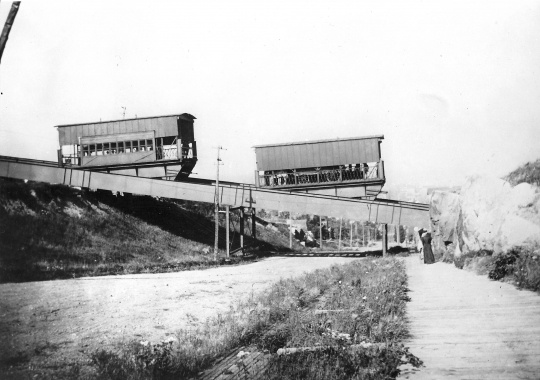
Duluth Incline
The Duluth Incline as it appeared with two large cars capable of carrying wagons and teams, crossing Fourth Street at Seventh Avenue, 1892.
Seventh Avenue West and Fourth Street, Duluth
Holding Location
Articles
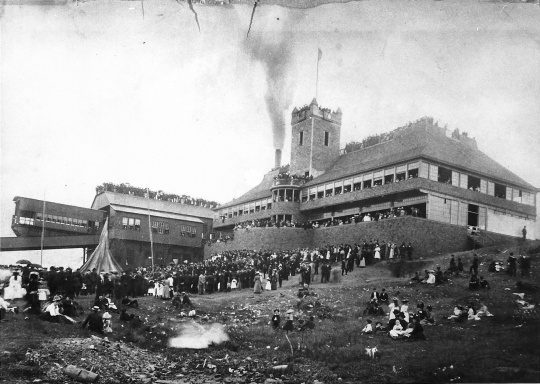
The Beacon Hill Pavilion
The Beacon Hill Pavilion, c.1892. the pavilion was built at the top of the Incline as an attraction to increase ridership.
Seventh Avenue West and Eighth Street, Duluth
Holding Location
Articles
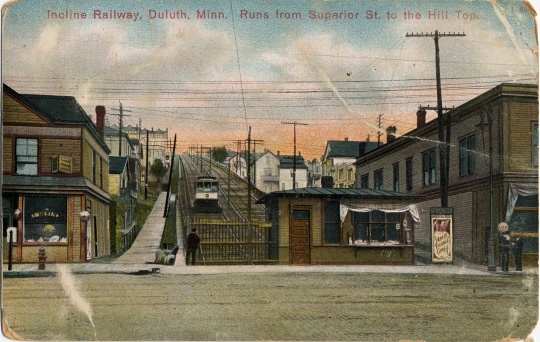
Looking up the Incline from Superior Street
Looking up the Incline from Superior Street, about 1907. The Incline is at it appeared in the years 1902-1911, with only a single car.
Seventh Avenue West and Superior Street, Duluth
Holding Location
Articles
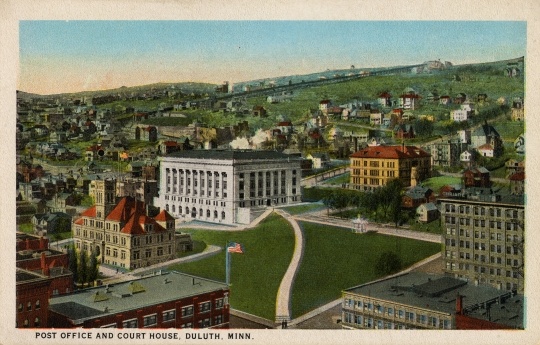
Looking west across downtown Duluth
Looking west across downtown Duluth, with the Incline in profile on the hillside, c.1910.
Creator: Duluth Photo Engraving Company
Holding Location
Articles
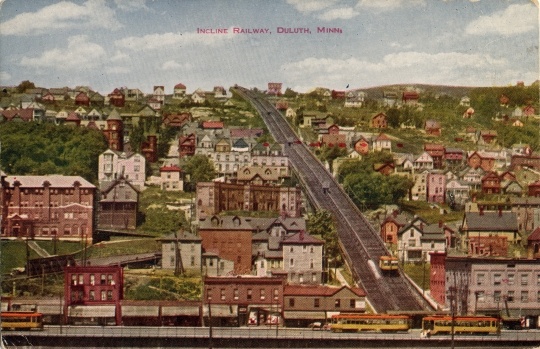
View of the Incline and Central Hillside
View of the Incline and Central Hillside from a grain elevator on Rice's Point, c.1910.
Seventh Avenue West, Duluth
Creator: V. O. Hammon Publishing Company
Holding Location
Articles
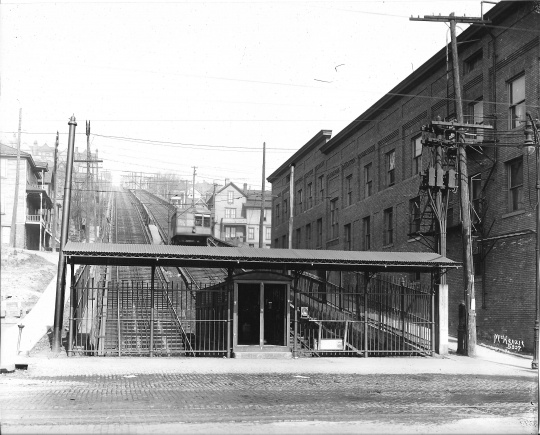
Looking up the Incline from Superior Street.
Looking up the Incline from Superior Street. The Incline is as it appeared in the period 1911–1939.
Holding Location
Articles
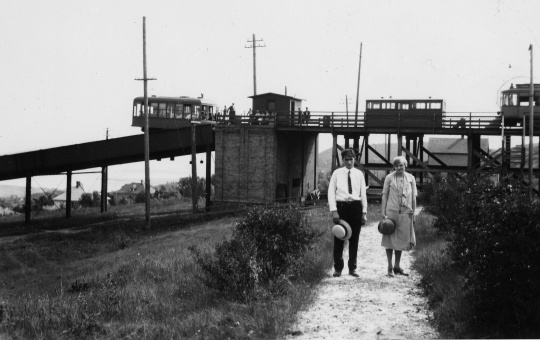
A couple posed in front of the top of the Incline station
A couple poses in front of the top of the Incline station at Seventh Avenue West and Eighth Street, Duluth, with an Incline car meeting the connecting Highland streetcar, 1926.
Holding Location
Articles
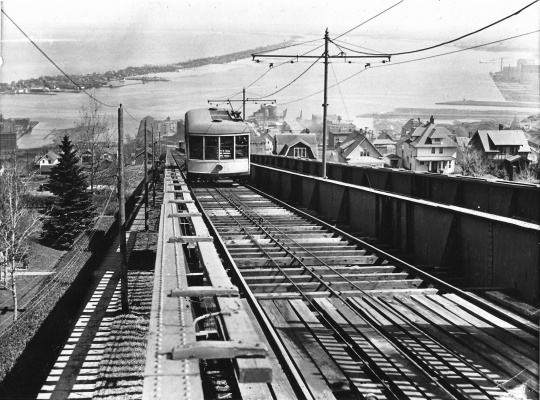
Looking down the Incline from the top
Looking down the Incline from the top, with a car on the east track and Park Point in the distance, 1930s.
Holding Location
Articles
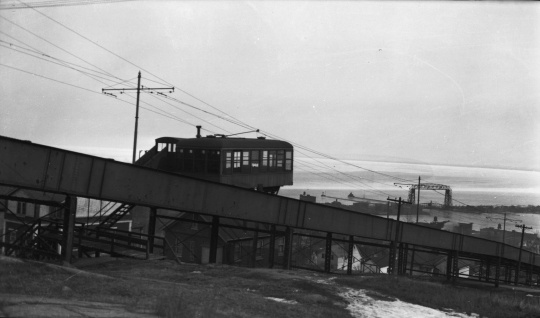
Car stopped at Fifth-Sixth Station
Looking down the Incline at a car stopped at the Fifth-Sixth Street station, 1933.
Holding Location
Articles
Related Articles
Turning Point
A fire in the powerhouse engine room on May 28, 1901 spreads to the pavilion on Beacon Hill, destroying both structures. The intense heat melts the cable, and a flaming Incline car is released to race down the track and demolish the base station at Superior Street.
Chronology
1891
1892
1901
1902
1911
1939
Bibliography
Central Electric Railfans Association. Badger Traction. Chicago: Central Electric Railfans Association, 1969.
Olson, Russell. The Electric Railways of Minnesota. St. Paul: H. M. Smyth Company, 1976.
Related Resources
Primary
S3020
Duluth-Superior Transit Company Records, 1881–1966
Northeast Minnesota Historical Center, University of Minnesota-Duluth
Description: Numerous departmental files from the company's years of operation, including information on the Incline railway, which the Duluth-Superior Transit Company acquired when all properties of the Duluth Street Railway Company were transferred to them in 1933.
Secondary
Broman, Ann. "A Brief Review of the Incline railway at Seventh Avenue West." Term paper, University of Minnesota-Duluth, 1955.
Dierckins, Tony and Maryanne C. Norton. Lost Duluth: Landmarks, Industries, Buildings and Homes and the Neighborhoods in Which They Stood. Duluth: Zenith City Press, 2011.
Skurla, Mike. "Early Public Transportation in Duluth." Term paper, University of Minnesota-Duluth, 1973.
Web
Minnesota Digital Library, Minnesota Reflections. Duluth Incline.
http://reflections.mndigital.org/cdm/singleitem/collection/msn/id/299/rec/1










